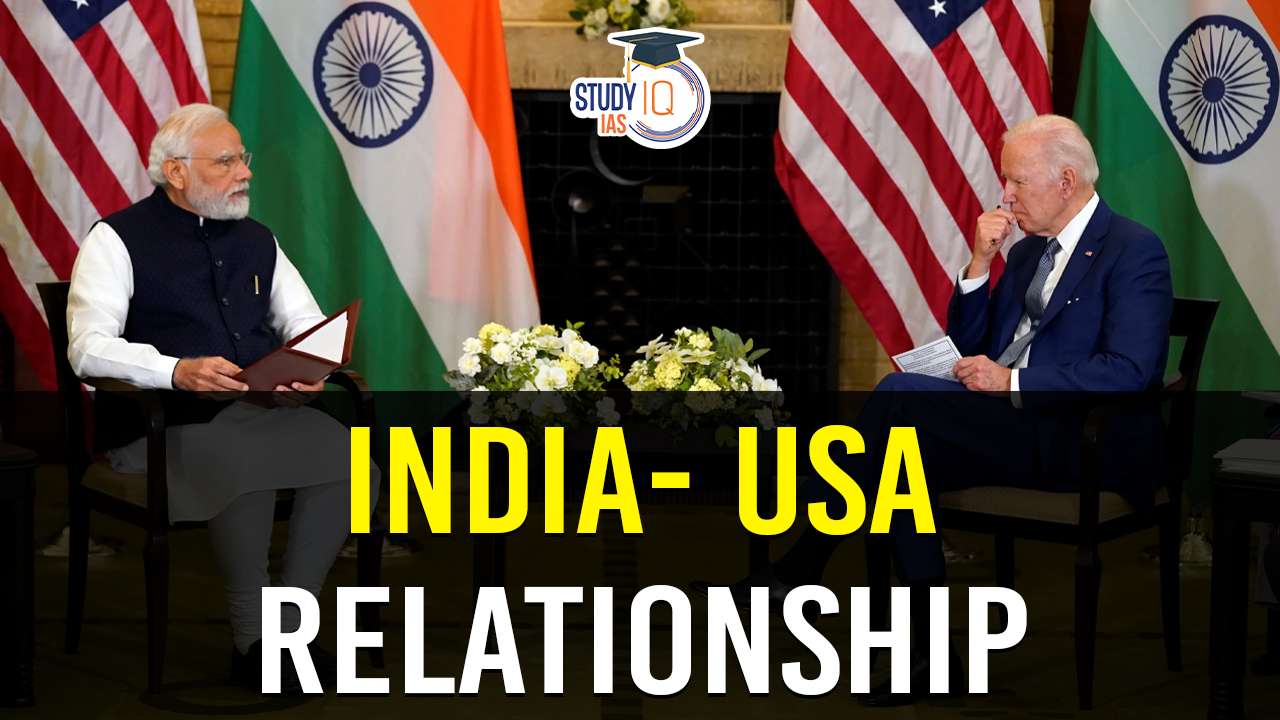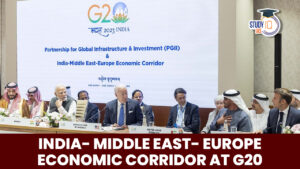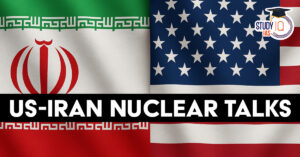Table of Contents
The relationship between India and the United States has evolved significantly over the past 25 years, moving from a state of uncertainty to a more stable partnership. This transformation is underscored by various factors that have strengthened ties, allowing for disagreements to be managed without disrupting the overall relationship.
India-USA Relationship: Introduction
- On July 24, 1991, Prime Minister P.V. Narasimha Rao’s government implemented broad economic changes to strengthen economic links with the United States.
- Finance Minister Manmohan Singh opened the Indian economy to international trade and investment, initiated privatisation, tax reforms, and inflation-control measures.
- The Indian government declared the completion of nuclear tests in Pokhran on May 11, 1998, drawing international outrage and harming India’s ties with the United States.
- President Bill Clinton imposed economic sanctions, as required under U.S. law.
- Over the course of two years, an extensive and committed interaction took place, involving 18 rounds of discussions between the former External Affairs Minister, the late Jaswant Singh, and the former U.S. Deputy Secretary of State, Strobe Talbott. This series of dialogues played a crucial role in reshaping perspectives.
- Later in the year 2005, U.S President George W. Bush lifted all the sanctions imposed on India.
- By means of a series of official visits, the relationship between India and the United States witnessed enhancement, signifying a transition from being labelled as “estranged democracies” to the status of “natural allies”.
India-USA Trade Deal
India and the United States share a strong economic partnership, which can be further solidified under Donald Trump’s second term. Key areas for enhancing trade relations include:
- Trade Agreement: India and the US were in talks for a comprehensive trade deal during Trump’s first term, which was paused. Both sides can now resume negotiations, focusing on reducing trade barriers, addressing tariffs, and balancing trade deficits.
- Energy and Technology: The US is a crucial energy partner for India, particularly in fossil fuels and renewable energy. Additionally, India looks to the US for emerging technologies, such as artificial intelligence, biotechnology, and advanced materials, crucial for India’s development.
- Entrepreneurship and Investments: Initiatives like the Global Entrepreneurship Summit have strengthened ties by fostering investment and business opportunities between the two countries. Enhanced trade policies can promote greater collaboration in innovation and entrepreneurship.
The trade relationship between India and the US presents significant growth opportunities, and with Trump’s return, both nations can finalize agreements to create a win-win scenario in the coming years.
Areas of Cooperation between India-USA
- Trade And Economy:
- America is one of the few countries with which India has a trade surplus. In 2022-23, India had a trade surplus of $28 billion with the U.S.
- The U.S. is the largest destination for India’s merchandise exports (almost 17% in 2023).
- The United States is India’s third largest investor, with cumulative FDI inflows of $66.70 billion (10%) from April 2000 to June 2024.
- Defence and Security Cooperation:
- India and the US have signed three foundational military agreements:
- LEMOA (2016): Logistics Exchange Memorandum of Agreement for mutual military logistics support.
- COMCASA (2018): Communications Compatibility and Security Agreement for secure communications.
- BECA (2020): Basic Exchange and Cooperation Agreement for geospatial intelligence sharing.
- India and the US have signed a Security of Supply Arrangement (SOSA) and Memorandum of Agreement regarding the Assignment of Liaison Officers
- A notable recent development is the approval by the U.S. Congress of a landmark deal between General Electric (GE) Aerospace and Hindustan Aeronautics Limited (HAL) to produce F414 fighter jet engines for the Indian Air Force. This deal includes:
- 80% Technology Transfer: GE will transfer a significant portion of its technology to India, allowing for local manufacturing of advanced jet engines.
- Joint Production: The agreement aims to produce 99 engines under India’s Light Combat Aircraft (LCA) program, enhancing India’s indigenous defence capabilities.
- India and the US have signed three foundational military agreements:
| Bilateral Military Exercises Between India And the US | |
| Army/ Navy/ Airforce | Name of the exercise |
| Navy | Rim of the Pacific (RIMPAC), MALABAR – Multilateral |
| Army | YUDHABHAYAS & VAJRA PRAHAR |
| Air Force | RED FLAG 16-1, Exercise COPE India 23 |
| Tri- military exercise | Tiger Triumph |
- Space Collaboration: India signed the Artemis Accords, establishing a shared vision for space exploration benefiting humanity.
-
- NASA and ISRO collaborated for India’s Mars Orbiter Mission and for a dual-band Synthetic Aperture Radar (NISAR).
- Multilateral Engagement:
- India and the US collaborate closely in international forums, including the UN, G20, IMF, World Bank, and WTO.
- Both nations are part of the Quad, alongside Australia and Japan, promoting a free and open Indo-Pacific.
- Nuclear Cooperation:
- The 2005 Civil Nuclear Deal saw India commit to separating its civil and military nuclear facilities, placing civil sites under IAEA safeguards. In return, the US agreed to enhance civil nuclear cooperation.
- Strategic Trust: Strategic trust has deepened through foundational agreements, military exercises, and maritime coordination. Shared concerns over China’s aggression have aligned India and the US internationally.
- Indian Diaspora: The number of Indians and Indian Americans in the U.S. is estimated at around 4 million, which accounts for almost 1% of the total U.S. population.
- It includes a large number of professionals, entrepreneurs and educationists with considerable and increasing influence in U.S. polity, economy and society.
- They are a big stakeholder in India-U.S. relations having significantly contributed to the growth and development of the U.S. economy.
- It includes a large number of professionals, entrepreneurs and educationists with considerable and increasing influence in U.S. polity, economy and society.
What are the Challenges between India-US Relation?
- Defence Cooperation and CAATSA: The Countering America’s Adversaries through Sanctions Act (CAATSA) poses a challenge as it restricts India’s defence purchases from Russia, impacting India-US defence ties.
- The US is concerned about India’s procurement of the S-400 system, which affects interoperability and secure communication.
- Economic Disputes: Disagreements persist on trade policies, patent rights, tariffs, and data privacy. The US prioritises strict IP protections, while India emphasises affordability.
- Ongoing trade disputes include US tariffs on Indian goods and India’s removal from the Generalised System of Preferences (GSP).
- Political and Regulatory Frictions: The US criticises India’s data localization rules and draft e-commerce policy as discriminatory.
- Disagreements also exist on foreign policy issues involving Pakistan, Afghanistan, and Iran, with the US opposing India’s stance on Iranian oil imports and Kashmir.
- Defence Dependence on Russia: India’s reliance on Russian military hardware, including the S-400 missile system, remains a point of contention.
- The US wants India to reduce its dependency on Russian defence equipment to avoid exposing US technologies.
- Divergent Positions in Multilateral Negotiations: Differences at the WTO, especially on trade and intellectual property rights, highlight tensions.
- The US and India often clash on issues like developing country status, subsidies, and IP waivers for COVID-19-related products.
- Khalistani Activism Incident: Relations have faced strain due to legal issues surrounding pro-Khalistani activist Gurpatwant Singh Pannun, whose case involves allegations against Indian officials for a failed murder plot.
- This incident has led to diplomatic tensions, especially concerning India’s internal security measures .
- Democracy Concerns: The U.S. has expressed concerns over India’s democratic practices, particularly ahead of India’s general elections.
- Statements regarding political arrests have caused friction, with India labelling such comments as “unacceptable” .
- Russia Relations: India’s ongoing relationship with Russia remains a contentious issue for the U.S., particularly following Prime Minister Modi’s visit to Moscow amid the Ukraine conflict.
- This has raised questions about India’s foreign policy alignment with Western interests
Way Forward
- Countering China: The emergence of China and the evolving geopolitical and strategic landscape in the Indo-Pacific, India and the United States consider each other as key strategic and natural partners.
- Proactive Regulation: To safeguard data privacy, avoid inequitable mergers, anti-competitive behaviours, and violations of competition law, and ensure free and fair taxes should be the next steps.
- Policy Alignment: In the context of NATO Plus Five, India quickly reiterated that the “Nato template doesn’t apply to India.” But India should note that the US is recognizing the need to work with a partner like India which doesn’t fit the mould of a traditional treaty ally that Washington is used to dealing with. If China continues with its assertive and aggressive foreign policy agenda vis-à-vis India, India’s options will have to evolve accordingly.


 India-Middle East-Europe Economic Corrid...
India-Middle East-Europe Economic Corrid...
 US-Iran Nuclear Talks: Key Developments ...
US-Iran Nuclear Talks: Key Developments ...
 EU Plans to Slash General Data Protectio...
EU Plans to Slash General Data Protectio...





















